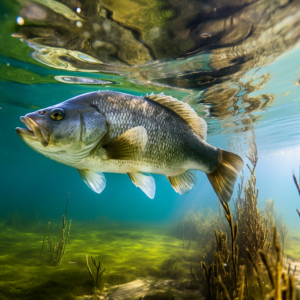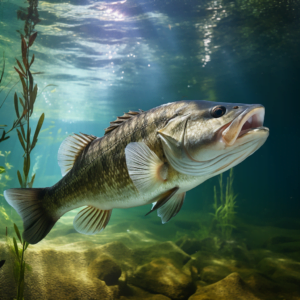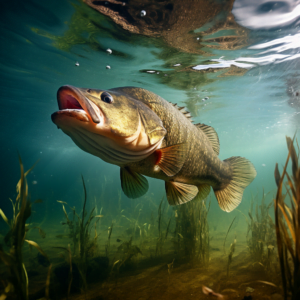So, have you ever wondered what happens if you accidentally leave a hook in a bass’s mouth? You know, those pesky little things that sometimes get stuck and you just can’t seem to get them out? Well, let me tell you, it’s not something you want to take lightly. Leaving a hook in a bass’s mouth can have some serious consequences, both for the fish and for you as a fisherman.
First of all, when a hook is left in a bass’s mouth, it can cause a lot of pain and discomfort for the fish. The hook can get caught onto the fish’s tongue, throat, or even their internal organs, and that can be extremely painful. Imagine having a sharp object stuck in your body! It’s not a pleasant experience, to say the least.
But the consequences don’t stop there. Leaving a hook in a bass’s mouth can also lead to serious infection and even death for the fish. If the hook isn’t removed properly and in a timely manner, it can become a breeding ground for bacteria and other harmful organisms. This can cause the fish to develop infections, which can quickly spread throughout their body. In severe cases, the infection can become so severe that it can lead to the fish’s death.
In the end, leaving a hook in a bass’s mouth is just not a good idea. Not only does it cause unnecessary pain and suffering for the fish, but it can also have serious consequences for their health and wellbeing. So, if you ever find yourself in a situation where you accidentally hook a bass and can’t seem to get it out, it’s always best to seek help from a professional or a more experienced angler who knows how to safely remove the hook. Trust me, it’s worth it for both you and the fish.
The Consequences of Leaving a Hook in a Bass Mouth
Fishing for bass can be an exciting and enjoyable activity for many anglers. Whether for sport or for food, the thrill of catching a bass is often followed by the responsible practice of catch and release. However, there are potential risks and consequences that can arise if a hook is left in a bass’s mouth. Understanding these risks, the impact on the bass’s health and survival, and the ethical considerations of catch and release fishing is crucial for every angler.
| Aspect | Details | Potential Consequences | Preventative Measures |
|---|---|---|---|
| Pain and Discomfort | Hook lodged in sensitive mouth areas | Stress, altered behavior | Use of appropriate hook size/type |
| Infection | Bacteria breeding on lodged hook | Disease, potential death | Safe, timely hook removal |
| Impaired Feeding | Hook interferes with natural eating | Malnutrition, slow growth | Proper hook-setting techniques |
| Increased Predation | Visible wound/discomfort attracts predators | Higher mortality rate | Use of barbless hooks |
| Population Sustainability | Hook injuries reduce bass’s reproductive capability | Decline in population | Advocating for catch and release |
| Ethical Fishing | Ensuring minimal harm to the fish during and after catch | Negative impact on fish | Employing safe removal techniques |
The Potential Risks and Consequences of Leaving a Hook in a Bass Mouth
Leaving a hook in a bass’s mouth can lead to various negative consequences, both for the fish and the overall ecosystem.
Infection and disease transmission are top concerns when a hook remains embedded in a bass’s mouth. The hook can introduce bacteria and pathogens, leading to the development of infections that can spread throughout the fish’s body. This can have serious implications for the bass’s overall well-being and survival.
Additionally, leaving a hook in a bass’s mouth can cause pain and discomfort for the fish. Bass have highly sensitive mouth structures, and a hook can cause irritation, inflammation, and even injury. The bass may experience difficulty in feeding and may exhibit signs of stress or discomfort, which can impact its ability to survive in its natural habitat.
Moreover, a hook left in a bass’s mouth can impair its feeding ability, potentially leading to reduced survival rates. The presence of a foreign object can hinder the bass’s ability to feed on its natural prey, ultimately affecting its growth and overall health. This can make the bass more vulnerable to predation and less likely to thrive in its environment.
The Impact on the Bass’s Health and Survival
Leaving a hook in a bass’s mouth can have long-term consequences for the fish’s health and survival. Vital organs within the mouth can be damaged if a hook is not properly removed. The bass may experience internal injuries or bleeding, which can significantly impact its ability to survive in the wild.
Furthermore, a bass with a hook in its mouth becomes more susceptible to predation. Predators can easily spot the wounded fish by observing its reduced ability to swim or feed normally. This increases the likelihood of the injured bass becoming prey, further compromising its survival.
The hindrance of normal feeding and growth is yet another consequence of a hook left in a bass’s mouth. With impaired feeding ability, the bass may struggle to obtain the nutrition it needs for optimal growth and development. This can negatively affect the bass’s size, reproductive capacity, and overall fitness in the ecosystem.
The Ethical Considerations of Catch and Release Fishing
Catch and release fishing is a popular practice among anglers, as it allows for the enjoyment of the sport while contributing to the conservation of bass populations. However, it is essential to consider the ethical implications of this practice, especially regarding the removal of hooks.
Responsible angling practices entail not only catching fish but also ensuring their well-being after release. Promptly and safely removing hooks from a bass’s mouth is essential to minimize unnecessary harm and potential long-term consequences. As anglers, it is our duty to respect the fish’s welfare and the sustainability of the ecosystem.
Conservation plays a vital role in preserving bass populations. By following responsible angling practices, including proper hook removal techniques, we can contribute to the overall health and well-being of bass populations. This includes reducing unnecessary harm, participating in catch and release initiatives, and educating others about the importance of preserving these valuable fish for future generations.
Proper Hook Removal Techniques to Minimize Consequences
To minimize the consequences of leaving a hook in a bass’s mouth, it is crucial to employ proper hook removal techniques. By using appropriate tools and equipment, such as needle-nose pliers or hook removers, you can safely detach the hook without causing further harm. It is essential to ensure that these tools are clean and disinfected to minimize the risk of infection.
Properly securing the bass and minimizing stress is also essential during hook removal. Gently handle the fish and try to keep it in the water throughout the process, if possible. This helps to reduce stress and the potential for injuries. Avoid excessive squeezing or handling of the fish, as this can result in further harm or distress.
When removing the hook, take your time and be gentle to minimize tissue damage. In some cases, it may be necessary to cut the line close to the hook and release the fish with the hook still intact. While not ideal, this approach reduces the potential harm caused by excessive manipulation.
Preventing Hook Injuries to Bass
Preventing hook injuries to bass begins with choosing the right hook size and type for the targeted fish. Using hooks that are appropriate for the bass’s size minimizes the risk of deep hooking and reduces the chances of injuring vital organs.
Avoiding deep hooking and employing techniques to reduce gut hooking are also crucial. Learn proper hook-setting techniques to ensure the hook is securely set in the fish’s mouth and reduce the likelihood of it becoming lodged in sensitive areas. Additionally, avoid using excessive force when reeling in a fish, as this can increase the likelihood of deep hooking.
Considering the use of barbless hooks is another effective way to prevent hook injuries to bass. Barbless hooks are easier to remove and cause less tissue damage, reducing the potential for infection or long-term consequences for the fish.
Educating Anglers and Promoting Responsible Fishing Practices
Raising awareness about the consequences of leaving hooks in a bass’s mouth is crucial for promoting responsible fishing practices. By educating anglers about the potential risks and consequences, we can influence behavior and encourage proper hook removal techniques.
Providing education and resources on proper hook removal techniques is also essential. Sharing step-by-step guidelines, demonstrating the use of tools, and emphasizing the importance of minimizing stress during hook removal can empower anglers to make responsible choices when catching and releasing bass.
Encouraging catch and release initiatives and voluntary participation is another way to promote responsible fishing practices. By highlighting the benefits of catch and release, such as sustainable fish populations and maintaining healthy ecosystems, we can inspire anglers to prioritize the well-being of bass and the environment over personal gain.
Regulations and Policies to Protect Bass Populations
Government regulations play a significant role in protecting bass populations. Catch limits and size restrictions are established to ensure sustainable fishing practices and prevent overexploitation. It is crucial for anglers to familiarize themselves with these regulations, adhere to them, and advocate for their enforcement.
Enforcement of fishing licenses and penalties for non-compliance are also important aspects of protecting bass populations. Responsible anglers obtain the necessary permits and licenses to fish legally, ensuring that the fishing industry remains sustainable and respects the environment.
Collaboration with fishing associations and organizations is key to promoting conservation and protecting bass populations. By working together, these groups can share knowledge and resources, advocate for policies that prioritize sustainability, and coordinate efforts to preserve the habitat on which bass depend.
The Role of Anglers in Preserving Bass Populations
Anglers have a vital role to play in preserving bass populations for future generations. By adopting a conservation mindset and practicing responsible fishing, we can have a positive impact on the health and well-being of these valuable fish.
Participating in citizen science initiatives to monitor fish populations is one way anglers can contribute to bass conservation. By collecting data on fish populations, anglers provide valuable insights into the status and trends of bass populations, enabling better-informed conservation efforts.
Contributing to habitat restoration and improvement projects is another meaningful way to support bass populations. By volunteering for initiatives that aim to restore or enhance bass habitats, such as removing invasive species, planting native vegetation, or improving water quality, anglers can help create healthier ecosystems for bass to thrive in.
Conclusion
Recognizing the potential consequences of leaving a hook in a bass’s mouth is essential for every angler. By understanding the risks and impact on the fish’s health and survival, as well as the ethical considerations of catch and release fishing, we can make more informed choices and promote responsible fishing practices.
Proper hook removal techniques, preventing hook injuries, educating anglers, and advocating for regulations and policies that protect bass populations are crucial steps in preserving these valuable fish. By working together, anglers can contribute to the conservation of bass populations, ensuring that they continue to thrive for future generations to enjoy. So, next time you capture a bass, remember the importance of promptly removing the hook and practicing responsible fishing. Your efforts can truly make a difference.




